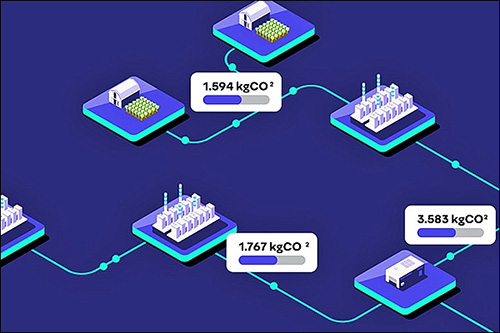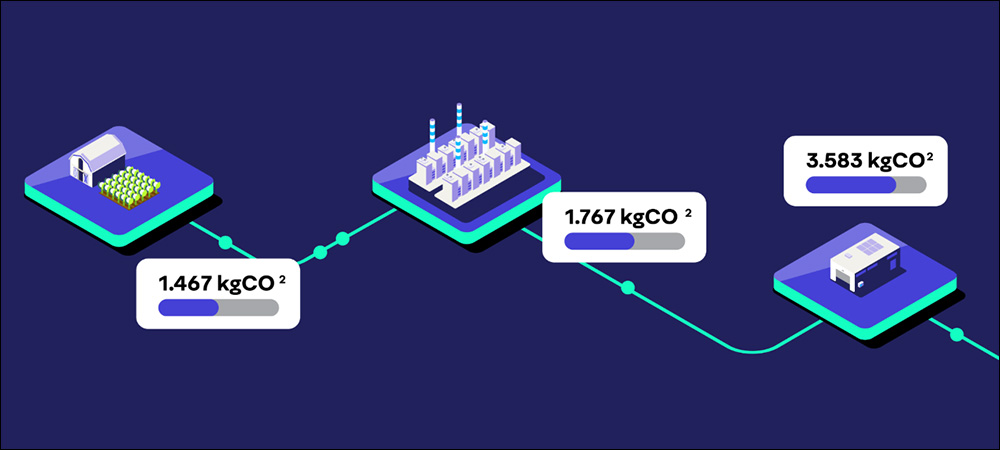With the adoption of RFID and other automatic identification technologies, companies are capturing data that brings visibility to their supply chains. This information has the potential to help businesses understand and address sustainability issues, such as excess energy usage and waste, and such details could be shared with consumers. But managing data and making it available to interested parties can be challenging. Avery Dennison has thus released two new features in its atma.io platform that can be used with the company’s management solution to help brands and retailers track the movements of goods from production to consumer, and to improve their sustainability.

Michael Goller
One tool, known as Real Time Carbon Impact Analytics, manages data about each product’s production and transportation to stores, then calculates emissions and captures data regarding which raw materials are used for production, as well as other details that can affect sustainability. This creates a carbon score and enables the sending of real-time updates. The second feature, the Real Time Waste Elimination Tool, utilizes artificial intelligence and machine learning to analyze and identify anomalies or inefficiencies taking place across the company’s supply chain, as well as the expiration dates of fresh foods. It can also send alerts if potential problems occur, according to Michael Goller, Avery Dennison’s atma.io technical director.
Atma.io was released last year as an Internet of things (IoT)-based platform to uniquely identify and monitor goods (see New Platform Centralizes Product Data from Factory to Disposal). Food and apparel brands, as well as logistics providers and retailers, can employ the platform to gain visibility into products throughout the supply chain. In recent years, the company has been especially focused on the value of its solution to ensure sustainability (see Avery Dennison Uses RFID for Sustainability).
Since the release of atma.io, Avery Dennison reports, businesses have been using the platform to gain awareness about their goods, and to improve efficiency, reduce loss and, in some cases, share content with customers, such as where or when a particular product was produced. The latter option is possible when companies use the platform with RFID technology, in conjunction with QR codes or Near Field Communication (NFC) on brand labels.
Measuring Real-Time Carbon Impact
Typically, whether producing food or apparel, brands have been tracking products with a unique digital ID number. If RFID is used, passive UHF tags are interrogated throughout the supply chain, while consumers can use the NFC reader, or QR or barcode scanner, built into their smartphones to obtain information about products, both in stores and after making purchases. Now, Goller says, with the atma.io-based data available to brands and retailers, some have been seeking further functionalities and features to leverage that information. The Real Time Carbon Impact Analytics tool provides brands with data-driven insights regarding the carbon footprint of their products.

Avery Dennison has added new sustainability tools to its Atmio.io platform.
“This is a powerful new tool that captures data from every stage of a product’s journey, from raw material to consumer,” Goller says, and it is designed to help companies comply with regulations, ranging from the digital product passport the European Commission intends to mandate later this year, to the FDA‘s existing Food Safety Modernization Act. For instance, as a men’s shirt or other product is being produced, a sustainability score is captured based on where and how that item is made. That could include information about the amount of energy used at a specific plant, a specific tool used, and the materials built into the shirt.
As that product was tracked throughout the supply chain, the score could be accumulated according to the amount of carbon required to transport it to a retailer. Once the item reached the store, the full score could then be displayed for customers when they scanned the shirt’s tag prior to purchase. This, according to the company, would help them decide whether they were purchasing a product that met their sustainability goals.
By creating an individual score for each product, Goller states, “It’s breaking this carbon impact really down to the item level, which is a very tangible way to inform consumers around what impact they are driving with the purchase of this specific item.” The Real Time Carbon Impact Analytics tool is designed to let brands evaluate sustainability in their supply chain as well. This is made possible, he says, by “capturing all the different data points that inform what carbon impact is created when you produce a single unit of an item, and then also making that information available to the different participants in in the supply chain.”
Avery Dennison is partnering with several blockchain companies to enable users to create an immutable record of each item’s carbon scoring, which would be stored on a distributed ledger so the data could be made available for those authorized to access it throughout the lifetime of the product or beyond. For analytics purposes, the tool could help businesses evaluate and compare sustainable practices and choices. For instance, if a company produces a specific product at two locations, Goller says, “[This tool] can measure and analyze the sustainability between production at location A versus location B,” and provide recommendations for ways to reduce the overall carbon impact.
Targeting Waste in the Food Supply Chain
The Real Time Waste Elimination Tool, which is leveraged in the food industry, can alert companies to potential problems. This includes information about the overdue movements of fresh products at the pallet level, or isolated individual items within a warehouse that are close to perishing or are missing.
Such features enable users to respond to events before waste can occur, by indicating when fresh products are delayed and thus ensuring goods reach stores well before expiration. A carton of lettuce, for example, could be tagged and tracked from the field through the supply chain, and its unique ID number, encoded on an RFID tag, could be linked to its expiration date. Users could then be directed to move that carton first if its expiration date was arriving before other products in a warehouse or on a vehicle.
The tool provides a solution that can be more reliable and easier to manage than manual “first in, first out” methods, Goller says. This feature, he explains, “gives new insights and enables users to really drive down waste across the different waypoints in their supply chain.” Users could, for instance, receive daily reports from their inventory system indicating what needs to be shipped first. The system picks products that need to be moved, he says, eliminating the need to dig for that information.
If companies couple data with sensor information, they can view updated expiration dates or alerts based on temperature excursions for fresh food before it reaches stores. Several businesses are currently piloting the new sustainability tools. Although Avery Dennison cannot yet share measurements specific to efficiency gains or reductions in waste, Goller says the numbers are significant.
Other new features introduced to atma.io include a tool called Sustainability Facility Assessments and Expiration Callouts, which provides more granular data from the Real Time Carbon Impact Analytics feature by assigning a manufacturing sustainability score for supported facilities within the supply chain. Another feature, Global Inventory Trace, monitors inventory at the item, stock-keeping unit and purchase order levels throughout the supply chain, which the company says reveals how inventory items are distributed per site type, such as at factories, warehouses or stores.
Moreover, the Anomaly Detection feature generates alerts regarding suspicious activities that may be occurring, based on unexpected changes to supply chain data. Finally, Purchase Order Tracking enables organizations to automate purchase order management and ensure proof of provenance for every inventory item being tracked. Going forward, Goller says, atma.io will continue to add new features for use with the platform.
Key Takeaways:
- RFID technology delivers the opportunity to understand and address sustainability challenges in supply chains.
- Avery Dennison’s digital tools are aimed at providing carbon impact visibility and the steps needed to address inefficiencies.
Exhibitors at RFID Journal LIVE! 2022 will offer tagging solutions for supply chain, manufacturing and sustainability. To learn more, visit the event’s website.


